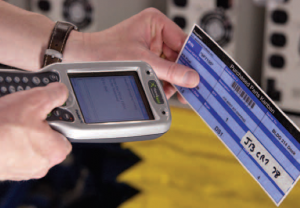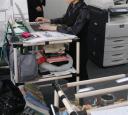Today I flew from my home in the Seattle area to New York’s La Guardia airport. This seems to nearly always be an adventure, but this one was unusual, so I wanted to comment on the customer’s perspective.
The flight routed through the airline’s major hub in Minneapolis (MSP) (so now you know which airline if you fly at all). No sooner than I had turned my cell phone on at the gate at MSP than it buzzed. I answered, and it was the airline’s computer talking.
I was informed that my flight from MSP to LGA had been canceled. This is never good news. I was informed that I had been re-booked on another airline (Midwest), and to contact the gate agent before going to the other airline’s counter. I was read a confirmation number, though sitting in an airline seat I really had no opportunity to write anything down, and was informed that all of the details were available on the airline’s web site – which is really no help unless I am on line in the airport. No big deal.
The gate agent is polite, lets me know that the other airline is “way over in Humphrey Terminal” and suggests another flight into Newark. “No, that’s OK, I want to go to La Guardia.”
I was much more concerned, at this point, about my luggage. Airlines, in general, do a reasonably OK job recovering from these things and getting people where they need to go. As a group, however, they don’t seem to “get” that it is important to the passengers (at least important to this passenger) that the luggage get there more or less at the same time I do.
I was cheerfully told that my luggage would be on their next flight to LGA, and I could pick it up “at my convenience.” This choice of words was interesting, it implied that I would easily just head back to the airport when my luggage got there.
One of the blind spots of all airlines is the illusion that the airport terminal is the final destination. Their job ends once they unload you there.
My only other option was to fill out a “missing luggage” claim with the secondary carrier (since they are responsible as the last airline I flew on), then they would get with the original carrier, arrange delivery to the hotel, etc. I pretty much resigned myself to having to go through that nutroll, and hoping beyond hope that it would get to the hotel overnight so I didn’t have to show up at Corporate HQ in “Seattle Casual.”
(I should relate the story of lost luggage when I had an 18 hour stay in Berlin sometime…)
Midwest Airlines flight 5 from Minneapolis to La Guardia stops in Milwaukee. When we arrived, we were informed this 30 minute stop was going to be a 2 hour stop due to “weather delays” in La Guardia. Not sure what that was about, the weather in La Guardia is beautiful tonight, but whatever. We actually got “release” after 1 hour, got on the plane, and headed east.
One thing I have to say – Midwest has a nice little niche service, and features “the most comfortable coach seating in the industry” by their claim. The seats certainly are nice, and I can’t complain about warm, gooey chocolate chip cookies either.
When I got to LGA, I thought “what the hell”, grabbed the shuttle bus and headed over to the NWA terminal to just see if they even knew where the luggage was. I arrived, was walking toward the luggage service office and there, coming out of the conveyor was my suitcase. How the hell that happened, I will never know. I picked it up, headed out of the terminal, caught the shuttle to the rental counter, waited behind the couple who could not rent a car because HE had the credit card and SHE had the driver’s license, got my car, and here I am.
Short Story: Somtimes good customer service happens purely by accident. It shouldn’t, but sometimes it does. Of course, the airline industry does a very good job of managing my expectations (i.e. keeping them low). I am always pleasantly surprised when they manage to deliver what they minimally promised.
Note To The Airlines: I try to not be one of those people who abuses the carry-on rules. If I have too much stuff, I check it. However – as a customer, it is important to me to arrive with my luggage. Sometimes that it more important than getting to the destination as soon as possible.



